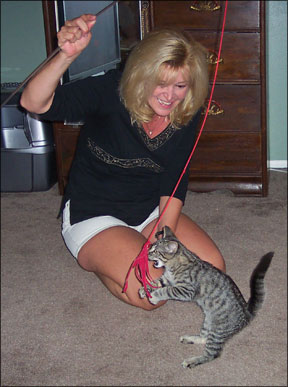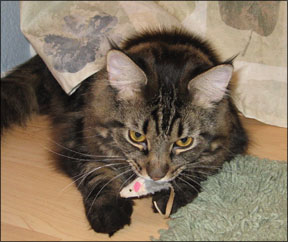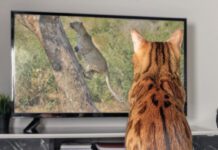The cat toy industry is booming in the United States partly because we love our kitties, but largely because our lifestyles make it difficult for them to engage in instinctual behavior without them. According to Dr. Julia Albright, resident in Animal Behavior at Cornell Universitys College of Veterinary Medicine, “Adult feral cats spend a good portion of the day looking for prey, whereas our indoor domestic cats do not.” Because our indoor kitties have no reason to hunt for their food, they have a lot more free time in a typical day. Dr. Albright states, “When a cat doesnt play or Bev Caldwell 288 exercise enough, I usually see one of two things occur: in younger cats, the energy is expended in appropriate ways – pestering, pouncing on humans or another cat, etc., whereas older cats have a tendency to become obese.” 
One of the best ways to encourage a cat to exercise is to offer opportunities to play. Kittens actually need very little encouragement compared to adult cats. Young kittens utilize play to hone their hunting skills; they will usually pounce, stalk or chase just about anything that moves. “Kittens begin playing at about three weeks of age – about the time weaning begins. Social play increases in kittens from four to 11 weeks and then rapidly declines; however, solitary play with objects starts to drop off at about four months old,” explains Dr. Albright.
This is the point where our indoor kitties sometimes become couch potatoes. Dr. Albright states, “Just leaving out a bunch of little toys like mice or cat balls and then just walking away is probably not going to cut it with adult cats; they usually need interactive play.” So, there are several variables to consider when deciding which cat toys to make available to your cat:
- Is the toy age appropriate? (older cats will probably need interactive toys)
- Does the toy engage the cats attention? Is it entertaining? Does it encourage movement? Is it safe?
Dr. Albright says, “Each cat is different, so owners need to experiment a little.” Toy mice and balls are great for young cats and that rare adult cat that will initiate play (its always good to have a few around the house, just in case): “Some cats, especially kittens, will fetch ping pong balls or crumpled paper. However, what usually happens is the cat will chase the ball or object and then stop … people will only get up and throw the ball so many times. I like the toys where owners can remain stationary because they wont tire out and the play period will last longer.” For interactive play, Dr. Albright suggests toys that are good at making the prey move: Cat Dancers (made from a loop of wire with inch rolled cardboard pieces attached at the end), feathers and feather toys on poles are just a few toys that fall into this category. “Another suggestion,” says Dr. Albright, “is getting a childs fishing pole, replacing the line and hook with a thicker string, and tying a feather or toy to the end. This is great because you can just sit on the couch and cast your line over and over again.”
Another approach, according to Dr. Albright, is to increase the motivation for solitary play: “To encourage your cat to play when you are away, use treat-dispensing toys; this will physically and mentally stimulate your kitty.” Some

Bev Caldwell
288
examples are the DeliDome and the Kitty Kong; the DeliDome spits out balls which the cat must bat around in order to get the kibble out, and the Kitty Kong makes it challenging to get the treats inside, as well. “You can also make your own treat-dispensing toy by capping the ends of an empty toilet paper roll, poking holes in it, and placing some kibble inside,” says Dr. Albright.
Of course, some kitties love to have a little plush toy to carry around and baby. And, adding a pinch of catnip can add a whole new dimension to playtime! Dr. Albright explains that catnip-filled toys can be a big hit; however, not all cats respond the same way. While some kitties go wild over a whiff of catnip, others simply walk away.
Cats also love to chase light reflections. Flashlights and pen lights dancing across the wall can elicit some goofy antics; however, there is some concern over the safety of using laser pointers as cat toys. Dr. Thomas Kern, DVM, board-certified by the American College of Veterinary Ophthalmologists, and Associate Professor of Ophthalmology at Cornell Universitys College of Veterinary Medicine, explains, “There is a large body of clinical literature on the hazards of laser pointers to vision, much of it contradictory. What seems to be consistent is that the intended use of pointers (for pointing) is safe. However, there is considerable evidence to show that in man, at least, it is possible to damage the retina with prolonged (greater than a few seconds) direct illumination of the eye.” In short, it is probably best to steer clear of these as cat toys and stick to reflections off of watches, jewelry and other everyday items.
Sometimes its the most unlikely things that prove to be the most entertaining – an empty paper bag (without handles) or cardboard box can offer seemingly hours of fun. Cats love to hide inside and attack unsuspecting passersby. However, Dr. Albright warns against using plastic bags as toys or paper bags with handles; your cat can ingest some of the plastic or become caught in the handle and injure herself trying to escape.
Rotating your cats toy selection will help ensure that they dont lose their entertainment value. Perhaps the most important thing to remember when choosing appropriate cat toys is to have fun – safely! If you are unsure about a toy, use discretion, and allow your cat to use it only under close supervision.



